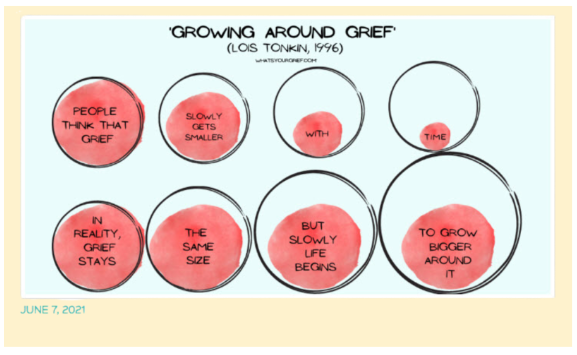August 5, 2024
Growing Around Grief: Grief and Recovery
Grief is an intensely personal and often overwhelming experience that affects each individual uniquely. It arises from various forms of loss, whether it be the death of a loved one, the end of a significant relationship, a major life transition, the loss of a dream, or even when our self-identity changes. But when we’re growing around grief, we can find ways to navigate and adapt to these profound changes in our lives.
The emotions and reactions associated with grief can vary widely, ranging from profound sadness and anger to confusion and numbness. If you're reading this, it's likely that you are currently navigating these turbulent emotions, either directly experiencing a loss or supporting someone else who is.
It's important to remember that you're not alone in this process; many of us are years in on our grief journey while others are just starting and aren’t quite sure how they can move on from here.
Despite the darkness that grief can bring, there is hope for healing and personal growth. It was about six months after my 14-year-old daughter, Jenna passed away that I remember feeling a glimmer of happiness in the moment. It took me aback because I was in so much pain.
“How could you feel happy and sad in the same moment,” I thought. And then it hit me. It was possible to feel two distinctly different emotions simultaneously.
So, even in the midst of deep sorrow, there are pathways to finding peace and resilience. This article is designed to offer you insights into the nature of grief, introduce you to a compassionate model that can aid in coping, and provide practical strategies to help you move forward on your journey toward healing and renewal.
The Reality of Grief
Imagine grief as a heavy stone placed in the center of your life. At first, it feels all-consuming, leaving little room for anything else. You find it hard to breath and difficult to think. You move through each moment, almost unaware that you are alive. This, unfortunately, is normal.
My grief counselor, Kathryn, always told me there's no "right" way to grieve, and the process doesn't follow a neat, linear path. Some days might feel impossibly hard, while others bring unexpected moments of peace or even joy. All of these experiences are valid.

Grief can manifest in various ways – emotionally, physically, and mentally. You might experience:
- Intense sadness or emptiness
- Anger or irritability
- Guilt or regret
- Physical symptoms like fatigue or changes in appetite
- Difficulty concentrating or making decisions
- A sense of disbelief or denial
- Withdraw
It's important to recognize that these reactions are natural responses to loss. They don't indicate weakness or a lack of faith. Instead, they reflect the depth of your connection to what or whom you've lost.
I said then and I still say to my girls, “The only way to deal with the pain is to allow the pain to move through you.”
Allowing yourself to feel what you need to feel is important. Then, when you are ready, consider what it looks like to live your love and depths of your connection out into the world. Allow that love to guide you and lift you up.
For when you connect to pure love, it is the one thing that can lift you out of the darkness and continually guide you towards the light.
The Tonkin Model: A New Perspective
Lois Tonkin's "Growing Around Grief" model offers a refreshing and hopeful way to view our grief journey. Instead of expecting the grief to shrink or disappear over time, Tonkin suggests that we grow around it. Picture that stone of grief again. While its size doesn't change, your life expands around it. New experiences, relationships, and meaning gradually fill the space, not erasing your loss, but allowing you to carry it within a life that continues to evolve and flourish. A life that continues to honor and illuminate the path ahead with light and love.
This model challenges the common misconception that we need to "get over" our grief or that time will make it disappear. Instead, it acknowledges that our connection to the person or thing we've lost remains a part of us. The goal isn't to forget or move on, but to learn how to integrate this loss into our ongoing life story.
Key aspects of the Tonkin model include:
- Acceptance of grief as a lasting part of life
- Focus on personal growth and expansion
- Emphasis on finding new meaning and purpose
- Recognition of the ongoing bond with what's been lost

Finding Your Path Forward
- Embrace Your Unique Journey: There’s no timeline for grief. Allow yourself to feel whatever emotions arise without judgment. Anger, sadness, guilt, and even moments of happiness are all part of the process. Some days you might feel overwhelmed, while others may bring unexpected peace. Trust that this variability is normal and part of the healing process.
- Seek Connection: Grief can feel isolating, but you don't have to face it alone. Reach out to trusted friends, family, or a grief support group. Sharing your story can be incredibly healing. Don’t be afraid to tell others what you need, whether it’s a listening ear, practical help, or simply silent company. Remember, seeking support is a sign of strength, not weakness.
- Honor Your Loved One: Find meaningful ways to keep their memory alive. This might be through creating a memory book, participating in a cause they cared about, or simply sharing stories about them with others. For our family it was starting the #hersmile Nonprofit, giving a scholarship to our local high school, and hosting the Jenna Betti Memorial Golf Tournament.
Consider establishing rituals or traditions that help you feel connected to your loved one. This could be as simple as lighting a candle on special days or as involved as starting a charity in their name.
- Practice Self-Care: Grief takes a toll on your mind and body. Prioritize rest, nutrition, and gentle movement. Small acts of self-kindness can make a big difference. This might include:
- Getting enough sleep and maintaining a regular sleep schedule
- Eating nutritious meals, even when you don’t feel like it
- Engaging in gentle exercise like walking or yoga
- Practicing relaxation techniques such as deep breathing or meditation
- Allowing yourself time for activities you enjoy, even if only for short periods
For two years after my daughter’s death, every week I hiked in the hills close to my house with a couple of girlfriends. I felt closer to my daughter in nature and it helped me also re-engage to a world that looked very different to me now.
- Explore New Meaning: As you grow around your grief, you may discover new purpose or perspectives. Be open to these changes, knowing they don’t diminish your love for the person you’ve lost. This might involve:
- Volunteering for a cause that feels meaningful to you
- Learning a new skill or hobby
- Deepening existing relationships or forming new ones
- Rediscovering aspects of yourself that may have been set aside
- Finding ways to help others who are also grieving
- Consider Professional Support: If you're feeling stuck or overwhelmed, don't hesitate to seek help from a grief counselor or therapist. These professionals can offer specialized tools and perspectives to support your healing journey.
When to see a doctor
Although there is no timeline for grief, contact your doctor or a mental health professional if you have intense grief and problems functioning that don't improve at least one year after the passing of your loved one.
A Story of Grief and Growth
Sarah lost her husband of 30 years to cancer. In the depths of her grief, she couldn't imagine ever feeling joy again. The world seemed colorless, and everyday tasks felt insurmountable. Slowly, with the support of a grief counselor and a widow's support group, Sarah began to grow around her grief.
She started by establishing a small ritual of lighting a candle each evening in memory of her husband. This simple act helped her feel connected to him and provided a moment of peace in her day. As weeks turned into months, Sarah found herself drawn to volunteering at a local hospice, channeling her pain into compassion for others facing similar journeys.
To her surprise, Sarah discovered a talent for writing as she journaled about her experiences. She eventually started a blog to share her story, connecting with others who were grieving and finding purpose in helping them feel less alone.
While the ache of missing her husband never fully disappeared, Sarah found new layers of meaning in her life. She deepened relationships with old friends and formed new ones through her volunteer work. She even found moments of genuine laughter and joy, no longer feeling guilty about experiencing happiness.
Sarah’s story illustrates how one can grow around grief. The loss remained a part of her, but it no longer defined her entire existence. Her life expanded to encompass new experiences, relationships, and sources of meaning, all while honoring the love she shared with her husband.
Remember, growing around grief is not about "getting over" your loss. It's about learning to integrate that loss into the fabric of your life, allowing for both sorrow and hope, remembrance and new beginnings. Be patient with yourself, seek support when you need it, and trust that growth is possible, even in the face of profound loss.
Your journey through grief is uniquely yours. There will be challenges, but there will also be opportunities for deep healing and personal growth. May you find strength, resilience, and unexpected moments of grace along the way. As you grow around your grief, may you discover that your capacity for love, compassion, and joy has expanded in ways you never imagined possible.
OUR MISSION
We are a nonprofit founded in honor of Jenna Betti, funding programs to empower and inspire people to thrive despite adversity.
Need Support Now?


